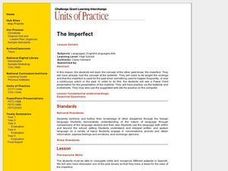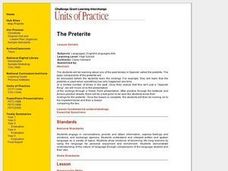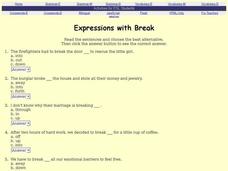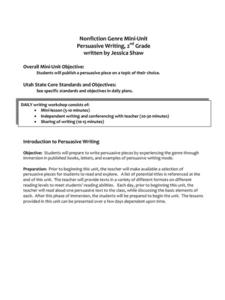Pearson
Non-Action Verbs
A verb is something you do — but can you always see the action? Use a slideshow presentation to clarify the differences between verbs that describe actions, and verbs that describe senses, preferences, and emotions.
Curated OER
Horse Character: Ceramics Lesson
Animals oftentimes elicit various characteristics which make them symbolic or representative of human feeling, action, or emotion. The class creates horse characters out of clay to show character action and symbolism. This is a great...
Curated OER
Phrasal Verbs - Emotions
For this online interactive ESL worksheet, students respond to 6 multiple choice questions regarding phrasal verbs. Students may check their answers with the click of the mouse.
Curated OER
ADULT ESOL LESSON PLAN--Effective Interpersonal Communication
Students explore various ways to express likes, dislikes, feelings, and emotions when communicating between people. They model these ways via pictures of food, weather, music, sports, cars, etc.
Curated OER
Strong Feelings
Students explore how emotions affect the decision-making of peacekeepers and design simulators for training emergency-response personnel.
Curated OER
English is Confusing (Adjectives Ending in -Ed or -Ing)
In this adjectives ending in -ed or -ing worksheet, students fill in the blanks to sentences and choose the correct verbs ending in -ing or -ed. Students complete 2 activities.
Curated OER
The Imperfect
Students practice the concept of the other past tense, the imperfect via the provided worksheet and the suggested web site.
Curated OER
ACE Expert English Homework Week 4- May 31, 2006
In this ESL worksheet, students complete the activities on 9 pages that pertain to emotions and adjectives that describe feelings. Included are matching, multiple choice, and short answer questions. These are geared toward ESL students...
Curated OER
The Preterite
Students practice one of the past tenses in Spanish called the preterite after the teacher presents the provided Power Point presentation.
Curated OER
What If?
Second graders read WHAT IF? up to the page that ends "Suddenly, across the field they saw..." and discuss how the animals are feeling. They then discuss their feelings and in pairs discuss a possible ending to the story.
Curated OER
Expressions With Break
In this expressions worksheet, students complete an 8 question multiple choice on-line interactive exercise about the meaning of expressions with "break".
Curated OER
PICTURE READING - PARAGRAPH WRITING
Students investigate the elements found in a media image. The image is used to compose a descriptive paragraph. They exchange papers to discuss the writing and make changes using constructive criticism. Students also make connections...
Curated OER
The Preterite vs. the Imperfect
Students write their own original studenT story in the past in Spanish using the imperfect and the preterite after watching the teacher present the provided Power Point presentation on the differences in the uses of the two.
Curated OER
Poetry for Home: Homelessness
Students read a poem to learn about homelessness. In this poetry lesson, students make a list of words about their home and then feelings about their home. Students read the poem 'When I Think Home' and then write their own version of...
San José State University
Commonly Misused Words
After reviewing two pages of commonly misused words: effect/affect, accept/except, there/their/they're, etc., learners must choose the proper word in ten different sentences. Note: Answers are listed at the bottom of page three.
The New York Times
Collateral Damage? Researching a Connection Between Video Games and Violence
Hook your class into an exploration of and discussion about violence in video games with a cute animal clip and a video game trailer. After a quick discussion about how media can affect mood, class members read a related article and...
Curated OER
What is a Haiku? How Do You Write a Haiku?
Haiku poetry is explored in this language arts lesson. Yong readers identify the characteristics of haiku and read several examples. Students make connections between their study of Japan and the poetic form of haiku, and they write...
Curated OER
Yikes! An Interjection!
In this grammar worksheet, students learn about using interjections in sentence writing. They then use what they learned to answer 9 questions. The answers are on the last page.
Curated OER
Combining Direct and Indirect Object Pronouns
Students combine direct and indirect pronouns in this instructional activity. They practice with rewriting sentences when a direct and indirect object is present. They create a story using PowerPoint with their new sentences.
Curated OER
Tone and Mood
How are mood and tone similar? Different? Help your readers understand the difference between the two with this helpful guide. On the first page, they read the definition for both tone and mood and identify words that are describe each....
Curated OER
Nonfiction Genre Mini-Unit: Persuasive Writing
Should primary graders have their own computers? Should animals be kept in captivity? Young writers learn how to develop and support a claim in this short unit on persuasive writing.
Curated OER
Yikes! Wow! An Interjection
In this grammar worksheet, students learn about interjections. They then use what they learned to answer the 14 interjection questions on the page. The answers are located on the last page of the packet.
Curated OER
Learning About Interjections
In this interjections learning exercise, students answer 4 facts about interjections and then write 2 original sentences using an interjection in each one.
Curated OER
Thanksgiving (ESL)
Students investigate a traditional American Thanksgiving. They recreate the first Thanksgiving in the classroom complete with food and appropriate decorations.























